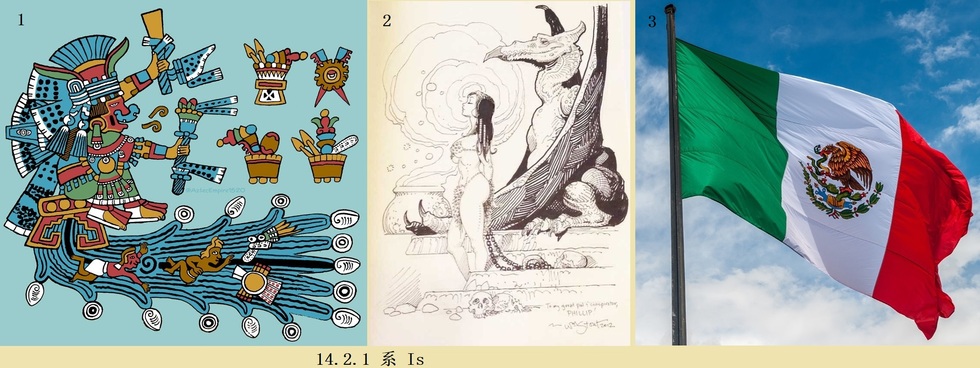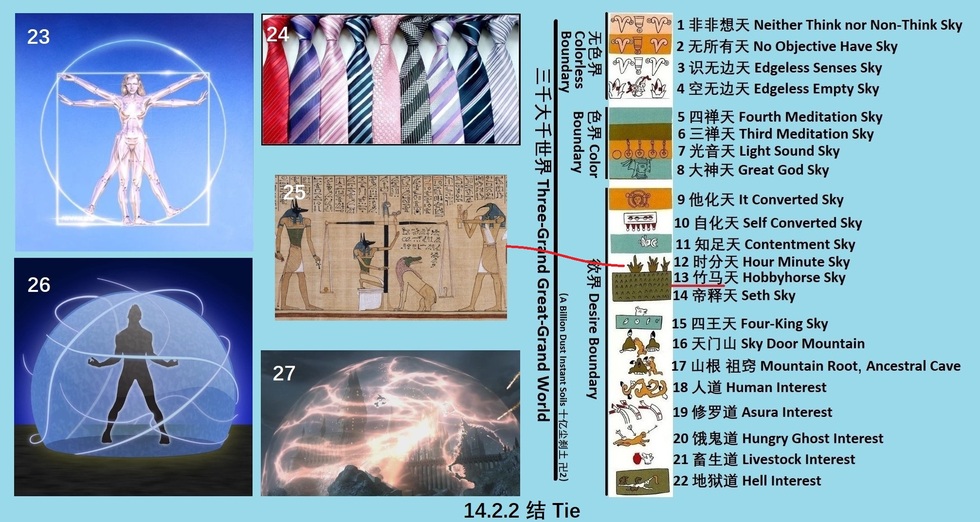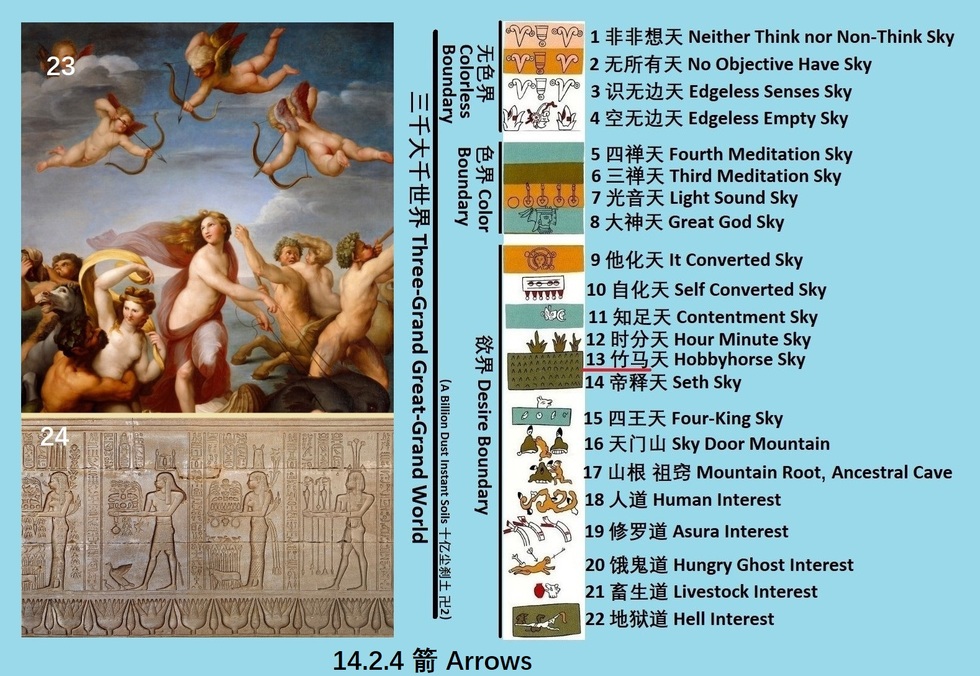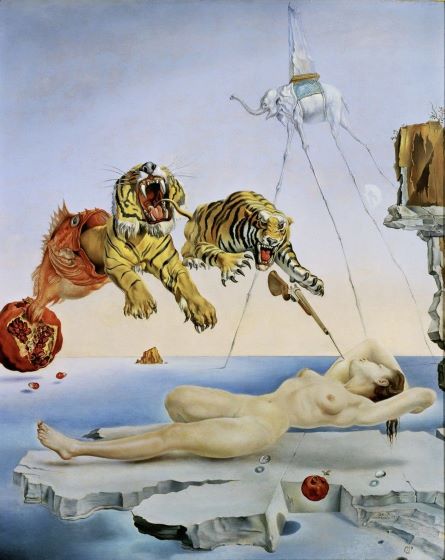14.2.0-6 烦恼的名
回答: 14 集谛 由 Adam_Luyan 于 2023-02-10 0:03
烦恼即糊涂,会令人感觉心绪嘈杂,身心沉重,是拘碍人身心的枷锁,有很多异名,此说26种:1系,2结,3取,4箭,5随烦恼,6随眠,7缚,8缠。9盖,10瀑流,11轭,12株杌, 13垢,14常害,15所有,16根,17恶行,18漏,19匮,20烧,21恼,22诤,23火,24炽然,25稠林,26拘碍。
Annoyances are muddles, which makes people feel noisy and heavy in body and mind, are fetters that hinder and detain the body and heart. There are many synonyms for them, of which 26 are mentioned here: 1 is, 2 tie, 3 fetch, 4 arrows, 5 latent annoyance, 6 following sleep, 7 binding, 8 coil, 9 cover, 10 cascade, 11 yoke, 12 stump, 13 maculate, 14 constant harm, 15 possession, 16 root, 17 ferocious behavior, 18 leakage, 19 deficient, 20 burn, 21 anger, 22 expostulation, 23 fire, 24 blazing, 25 thick forest, 26 detention.14.2.1 系 Is.系即系表动词是,系缚义,缔结生命义,参见前节的注6。为什么系是烦恼呢?前节案例说了,通过夏娃识的认可(即是),她和亚当识通力合作,很短的时间内就创造了一个尘刹土世界,包括其中的众生和事物。夏娃识制造生命很快,像似水流一样,如图14.2.1-1是墨西哥的夏娃翠玉女,生命之水(即众生和意义)从她的裙子上就流出来了。现实生活中此二识日夜创造众生和事物,而那些都分食 “心识流”,让人心绪嘈杂,身心沉重。所以夏娃识也被称作污染识;亚当识包含了许多坏种,过失也很严重。古人为了提醒后人系的危害,把生命之树上的解脱果命名成了离系果(参见11.6.4节《离系果》)。系有四种:1贪欲身系,2瞋恚身系,3此实执取身系,4戒禁取身系。
“IS” is the verb “is”, means tether, tethering life, (see annotation 6 in the previous section). Why is “is” an alias of annoyance? The case of the previous section says that through cognition (i.e., is) of Eve-sense (i.e., preconsciousness), and Adam-sense (i.e., maculate part of unconsciousness) cooperated to create a “dust instant soil world”, including the beings in it, in a very short time. Eve-sense creates lives very quickly, like water flowing, as in Figure 14.2.1-1, which shows the Mexican Eve Chalchiuhtlicue, with the life-water (i.e., sentients and meanings) flowing right out of her dress. In real life these two senses create sentients and things day and night, and which all partake of the senses-stream of heart, make one's heart and body heavy. Therefore, Eve-sense is also called Contamination; Adam-sense contains many bad seeds, so also with serious faults. In order to remind future people of the harms of Is., ancients named the fruit of liberation on Tree of Life the Off-is Fruit (see Section 11.6.4, Off-is Fruit). There are four kinds of is-es: 1 greedy-desire body-is.; 2 irritation-anger body-is.; 3 is-real obsessively-fetch body-is.; 4 precept-taboo-fetch body-is.
一)贪欲身系,由贪爱财物等为因,所贪爱的事物系缚于心,另心变得粗重。贪爱得多了,心意就散乱了;此说,贪欲能障碍绑缚心之自体,另心识流分散。
1) Greedy Desire Body Is. is caused by the craving for possessions, etc., which bind up the body and heart, and make the heart rough and heavy. The heart becomes scattered when there are many greedy desires; this means that greed and desire can bind up self-body of heart and disperse heart-senses stream.插图14.2.1-2是《墨西哥法典》中对系烦恼的表述。故事约发生在公元1325年,国王舍利王把王位传给了自己的教子墨西哥,可他死时墨西哥还流亡在国外,于是他任命自己的女儿卡特莉(即那个阶段的翠玉女)为代理国王,等待墨西哥归来后再把王位传给他。可是卡特莉很贪婪,想自己当国王,也因此对舍利王和墨西哥很气愤,所以她想暗杀墨西哥于归来的途中。
Illustration 14.2.1-2 is a representation of annoyance “is” from Mexican Codex. The story goes that in about 1325 C.E., King Huitzilopochtli passed the throne to his godson, Mexico, but Mexico was still in exile when he died, so Huitzilopochtli instructed his own daughter, Tlaltecuhtli, who was Chalchiuhtlicue at that stage of her life, to be the deputy king and wait for Mexico's return to pass the throne on to him. But Tlaltecuhtli was greedy and wanted to be king herself, and was therefore angry with Huitzilopochtli and Mexico, so she wanted to assassinate Mexico on his way back.墨西哥发现后,认为卡特莉是她自己 “贪欲和瞋恚” 的囚徒 (如图2,那怪物是蛇、鳄鱼、和鹰的结合体)。据传说,一天墨西哥看到了墨西哥国旗上的图案(如图3),意识到了卡特莉就是图上的那只鹰或凤凰,如果她自己吃掉自己的贪婪,可以胜任众生之母。图上的蛇象征着贪婪,因为蛇吃蛋不吐皮,吞鸟毛不剩。于是把墨西哥(是一位亚当转世,异名特拉洛克)的王位作为求婚的聘礼送给了卡特莉;翠玉女(是随后卡特莉;是一位夏娃转世)就成为了墨西哥帝国的开国皇帝。所以,此二人就成为墨西哥民族的始祖,而舍利王就成为了墨西哥的太阳神。
When Mexico found out, he believed that Tlaltecuhtli was the prisoner of her own "greed and anger" (Figure 2, the monster is a combination of snake, crocodile and eagle). According to legend, one day Mexico saw the picture on the Mexican flag (fig. 3) and realized that Tlaltecuhtli is the eagle or phoenix in the picture, and that she could be competent as the mother of all beings if she ate her own greed. The serpent on the picture symbolizes greed, for a snake eats eggs without spitting out the shells and swallows a bird without leaving feathers. So, Mexico (is an incarnation of Adam; aka. Tlaloc) gave Mexican throne to Tlaltecuhtli as a marriage proposal gift to satiate her; so Chalchiuhtlicue (i.e., later Tlaltecuhtli; is an incarnation of Eve) became the founding emperor of the Mexican Empire. Therefore, the two became the primogenitors of Mexican Nationality, and Huitzilopochtli became Mexican Sun God.二)瞋恚身系,由诤斗故,众生多行不正;此不正确的行为能绑缚心之自体,令心散乱。
2) Irritated-Anger Body Is. Due to expostulations and fights, sentients behave incorrectly, which incorrect behaviors can bind the body and heart, and cause the heart to be scattered.
三)此实执取身系,由不如理作意,推求境界妄生执着我见、边见、邪见、和见取见(参见11.4.4.1.4《根本烦恼》),计唯此真实,余皆愚妄。由此为因,令心散乱。
3) Is-real Obsessive-Fetch Body Is. Due to not according to theories to make intents, reasoning from desirably perused environment, one illusively obsesses to Seth-view (cf. section 11.4.4.1.4 Fundamental Annoyances), edge-view, heresy, or heretical-view, believes which is the only real, the rest are all foolish delusions. Because of this reason, heart is in dispersion. 四)戒禁取身系,对于戒禁不能正却理解,肆意曲解,旺兴执着,由无利勤苦为因,令心散乱。
4) Precept and Taboo Fetch Body Is. Precept-fetch means that to the precepts and prohibitions, one does not understand correctly, indulge in misunderstanding, compassionately obsess to the fetched views from precepts and taboos; due to which bitter of nonbeneficial diligent labours, heart is in dispersion.14.2.2 结 Tie据说,这里谈的结(如图14.2.2-24所示)和后文的盖头、帽子、围巾等都是上帝给亚当和夏娃穿的衣服,称作心衣。衣服的尺寸就是衣服的功能范围,如图23、26、27所示。插图25源自古埃及壁画,描述的是时分天正在称量心重,重一根羽毛可以通过。心是思想意识义,没有重量;他们实际是在称量心衣的重量。佛教中称此心衣的功能范围为结界。结界就是电影或故事中的神秘场力,本质是隐私空间,防卫心、忌讳、猜疑、恐惧等的势力,(参见6.6节的案例)。另外,本书11.4.4节《行蕴》中的某些善法也被称作心衣;16.2节的具足戒,又名黄金甲,金缕衣等。
The ties talked about here (shown in Figure 14.2.2-24) and the covers, hats, scarves, etc., later in the text are said to be the Heart Cloths that God made to Adam and Eve to wear. The sizes of the cloths are the range of cloths’ functions, as shown in Illustrations 23, 26, and 27. Illustration 25 is derived from an ancient Egyptian fresco depicting the Hour-Minute sky were weighing the heart, weighing a feather to pass through. The heart means mind, weightless; they were actually weighing the heart cloths. In Buddhism, the ranges of heart cloths’ functions are called Tie Boundaries. Tie Boundaries are the mystical field force in movies and stories, essentially spaces of privacy, self-defending heart, taboos, suspicions, fears, etc., (see the case in section 6.6). In addition, certain benevolent laws in the book's section 11.4.4 are also known as the heart cloths; and the full precepts of section 16.2, also known as the Golden Armor, invisibility cloak, and so on.
爱结、嗔结、痴结等九结能绑缚人于苦恼的处境,和合众苦,树立结界,使人的本心遭到污染、覆盖和摧残,从事无利尘劳。结界的界是种子义(参见11.2节),因为众生依界而生。一切烦恼皆能合苦,爱、恚等九法尤为强烈,故取九结来说明。这九结是:爱结、恚结、无明结、慢结、疑结、见结、取结、嫉结、悭结。
The nine ties of love, irritation, and ignorance, etc. can bind people in afflictive situations, combines crowds of bitterness, and set up Tie Boundaries, which contaminate, conceive, and torture people’s hearts, to have them pursue unbeneficial dust labors. The word boundary of Tie Boundary means Seed (see section 11.2), because sentients depend on boundaries to live, to grow. All annoyances can combine bitter, but love, irritation, etc. nine laws are particularly serious, therefore, the nine ties are used to illustrate. The nine ties are: love tie, vexation tie, non-light tie, view tie, fetch tie, arrogance tie, suspicion tie, jealousy tie, and stingy tie.一)爱结,以染着为性,是贪的相分(参见11.1节《法的四分》),对于顺境中所感乐受,希望能长期持有。一切烦恼皆能合众苦,就是因为贪爱。众生为贪爱故,广行不善,遂招致当来的不平等、不正确、生老病死忧恼之苦,流转于惑业苦的恶性循环(参见13.4.1 流转),不能出离。
1) Love Tie, love is by dye, clinging as nature, is greed’s phenomenal quadrant (see section 11.1 Juristic Quadrants), is the desire to hold on to the pleasures in enjoyable environment for a longer time. It is because of greedy love that all annoyances are combining crowds of bitter. Because of greedy love, sentient beings perform a wide range of non-benevolences, which leads to the inequality, incorrectness, bitterness of birth old illness and death, and stuck in the vicious cycle of muddle, karma, and bitterness (see 13.4.1 Cycle), from which they can not be free.二)恚结,以愤恨为性,对于违境所感苦受,所起不愤的情绪及嗔恚之想。众生为嗔恚故,广行不善,遂招致当来的不平等、不正确、生老病死忧恼之苦,流转于惑业苦三轮(参见13.4.1 流转),不能出离。
2) Vexation Tie, is by anger and hate as nature, is the acceptances of resentment and the thinkings of irritation and hate. Because of irritation and hate, sentient beings perform a wide range of non-benevolences, which leads to the inequality incorrectness and bitterness of birth old illness death, stuck in the vicious cycle of muddle karma and bitterness (see 13.4.1 Cycle), from which they can not be free.三)无明结,无明(参见前一小节的注1)即无知、愚痴;即于违顺诸境,苦乐诸受,所起的与道理相违愚痴之想。无明结是说众生心性为无明所覆,于集谛的因法和苦谛的果法不能了解,广行不善,遂招致当来的不平等、不正确、生老病死忧恼之苦,流转于惑业苦的循环(参见13.4.1 流转)之中,不能出离。
3) Non-light Tie, the non-light is the dimness in previous section annotation 1, means ignorance, fool, are irrational foolish thinkings that arise in the midst of either adverse or advantageous etc. environments, bitter or happy etc. acceptances. The non-light tie means that sentient beings' hearts are so conceived by non-light that they are unable to understand the cause laws of chapter 14 Aggregate Crux, and the fruit laws of chapter 13 Bitter Crux, perform a wide range of non-benevolences, which leads to the inequality, incorrectness, bitterness of birth old illness and death, and stuck in the vicious cycle of muddle, karma, and bitterness (see 13.4.1 Cycle), from which they can not be free.四)见结,谓众生于我见、边见、邪见、见取见、戒禁取见(此五恶见参见11.4.4.1.4节),妄兴执着,广行不善,遂招致当来的不平等、不正确、生老病死忧恼之苦,流转于惑业苦三轮,不能出离。
4) View Tie, saying that sentient beings compassionately obsess I view (i.e., Seth View), edge view, heresy, view fetch, and precept fetch (for the five ferocious views, see section 11.4.4.1.4), perform a wide range of non-benevolences, which leads to the inequality, incorrectness, bitterness of birth old illness and death, and stuck in the vicious cycle of muddle, karma, and bitterness (see 13.4.1 Cycle), from which they can not be free.五)取结,取即所取和能取;所取者是受,能取者是想。此二取习气,即受蕴和想蕴(参见11.4.2, 3 节),是世间本。取结是说众生于所取、能取不能了解,妄意随顺执着此二取习气,广行不善,遂招致当来的不平等、不正确、生老病死忧恼之苦,流转于六道轮回,不能出离。
5) Fetch Tie, fetch includes the capable to fetch, which is think, and the being fetched, which is acceptance. The two fetch habits are Think Node and Acceptance Node (see section 11.4.2.3). Fetch tie means that sentient beings are unable to understand what is the able to fetch and what is the being fetched, they delusionally yield to the two fetch habits, and perform a wide range of non-benevolences, which leads to the inequality, incorrectness, bitterness of birth old illness and death, and stuck in the vicious cycle of muddle, karma, and bitterness (see 13.4.1 Cycle), from which they can not be free.六)慢结,谓不懂我法,妄执我及我所而凌驾于它人。慢结是说众生依仗自己所擅长,于它有情高举傲慢,广行不善,遂招致当来的不平等、不正确、生老病死忧恼之苦,流转于六道轮回,不能出离。
4) Arrogance Tie, saying that sentient beings do not understand I law (i.e., Seth view), illusively lifting I and mine above others. Arrogance tie means that depending on advantage, one arrogantly lifts oneself over other sentients, and perform a wide range of non-benevolences, which leads to the inequality, incorrectness, bitterness of birth old illness and death, and stuck in the vicious cycle of muddle, karma, and bitterness, from which they can not be free.七)疑结,谓众生于四胜谛(参见第11-16章)的人生道理妄生疑惑,不修正行,广行不善,遂招致当来的不平等、不正确、生老病死忧恼之苦,流转于惑业苦的循环流转,不能出离。
7) Suspicion Tie, saying that that sentient beings suspect the life principles of Four Victorious Cruxes (chapter 13 through 16 of the book), do not cultivate correct behaviors, perform a wide range of non-benevolences, which leads to the inequality, incorrectness, bitterness of birth old illness and death, and stuck in the vicious cycle of muddle, karma, and bitterness (see 13.4.1 Cycle), from which they can not be free.八)嫉结,谓众生耽着名利,见它荣富,起嫉妒心,广行不善,遂招致当来的不平等、不正确、生老病死忧恼之苦,流转于惑业苦三轮,不能出离。
8) Jealousy Tie, saying that sentient beings are obsessed with fame and wealth, become jealous when they see others fame and wealth, so they perform a wide range of non-benevolences, which leads to the inequality, incorrectness, bitterness of birth old illness and death, and stuck in the vicious cycle of muddle, karma, and bitterness, from which they can not be free.九)悭结,谓众生耽着名利,于资生具,其心贪吝,不能舍施,广行不善,遂招致当来的不平等、不正确、生老病死忧恼之苦,流转于六道轮回,不能出离。
9) Stingy Tie, saying that sentient beings are obsessed with fame and wealth. Their hearts are greedy and stingy on life assets, unable to donate, so they perform a wide range of non-benevolences, which leads to the inequality, incorrectness, bitterness of birth old illness and death, and stuck in the vicious cycle of muddle, karma, and bitterness, from which they can not be free.14.2.3 取 Fetch取义为执取诤根和执取后有;有四种:欲取,我语取,见取,戒禁取。欲取依欲界而建立;后三种依色界和无色界而建立。欲界、色界、和无色界,这三个概念参见第13章苦谛。
Fetch means “obsessively fetch expostulating-root”, and “obsessively fetch later-have”; there are four kinds: desire fetch, I-lingual fetch, view fetch, precept fetch. Desire fetch is established on Desire Boundary; the last three are established on Color Boundary and Colorless Boundary. For the concepts of desire boundary, color boundary, and colorless boundary see chapter 13 Bitter Crux.一)欲取,谓欲界众生贪着饮食、睡眠、和性行为等色声香味触五欲,为获得受用,互相斗诤。这斗诤的根本是五欲取。
1) Desire Fetch, saying that sentient beings crave color sound incense taste and touch, the five kinds of desires, such as food, drink, sleep, and sexual intercourse. In order to enjoy the acceptances of those five dusts, they expostulate and fight with each other. The root cause of these expostulations and fights is the Five Desire Fetches.二)我语取,谓依我见而取;我语就是口语中的我字,即转移身见,梵语萨迦耶见,英语塞斯,纳瓦特尔语Titlacauan(义为我们是它的奴隶)。。当我见破败时,世人又妄执六十二种边见和邪见(参见11.4.4.1.4 根本烦恼)。此三种见就是被执取的诤根。下文的见取和戒禁取是依此诤根而执取后有。
2) I Lingual Fetch, saying that depending on I-view to fetch, “I” is the oral saying of me, I-view means Seth view, Chinese calls “translocation body view”, Sanskrit is sakkāya-diṭṭh, Nahuatl Titlacauan that means we are its slave. When Seth-view is broken, mundane people illusively cling to the 62 Edge-views and Heresies (see section 11.4.4.1.4 Fundamental Annoyances). These three kinds of views are the expostulating roots of being obsessively fetched. The following View Fetch and Precept Fetch are depending on the expostulating roots to obsessively fetch later haves.三)见取,即根本烦恼恶见中的一百零八种见取见,谓于诸见及所依蕴,执为最胜,认为执彼能得清净涅槃。
3) View Fetch, that is the 108 kinds of “Views fetched from Views” among the Ferocious Views (see section 11.4.4.1.4.6-4), saying that obsessively holding views and their dependent node as the most victorious, they believe in by doing so, can gain immaculate nirvana.四)戒禁取,戒条总说为男人的三千威仪八万四千细行和女人的五百威仪十万八千魅力(参见16.2节《离垢地》),世人对戒条的某些条款曲解妄执,认为持彼戒禁能得涅槃,如执行性器官割礼,和尚不吃肉等。
4) Views Fetched from Precepts and Taboos, generally to say precepts are, 3,000 Majesties and 84,000 Enchantments for man, and 500 Majesties and 108,000 Charms for woman (see section 16.2). Mundane people have misinterpreted and deluded themself into believing that holding some practises and precepts can gain salvation, such as using tap water to baptise, genital circumcision, and monks not eating meat, etc.14.2.4 箭 Arrows贪瞋痴三毒能射伤行人,使行人于有果法及三有的因,深起追求,由是生死相续不绝,故立名贪嗔痴为三支箭。
Greed, Irritation, and Ignorance, the three poisons can shoot, injure migrators, causing them to compassionately pursue the “have fruit laws” and the causes of Three Haves, thus, birth and death succeed each other unceasingly, therefore Greed, Irritation, and Ignorance are set up the name of three arrows.
“有果法” 是说有人认为插图14.2.4-13 至-1的成就有,存在。又由于贪瞋痴是有的组成部分,所以追求“有果法”的人就已经中箭了,就已经被贪嗔痴射伤了,为什么?因为插图14.2.4-13及以上都是无为法(参见11.6.4节《离系果》),只与舍和空性相应,与取、集、和得的性质相违。三有就是欲界、色界、和无色界。
“Have Fruit Laws” is saying that some people believe that the accomplishments in Illustrations 14.2.4-13 to 1 have, exist. And because Greed, Irritation, and Ignorance are components of haves, so those who pursue “Have Fruit Laws” are shot, wounded by greed, irritation, and ignorance, wherein? This is because Illustration 14.2.4-13 and above are all Non-as Laws (see section 11.6.4 Off-is Fruit), corresponding only to the nature of renunciation and emptiness, and contrary to the nature of fetch, aggregate, and gain. The three haves are Desire Boundary, Color Boundary, and Colorless Boundary.插图14.2.4-24源自古埃及壁画;图中埃及夏娃正在展示洗礼的过程。图2中她的头顶有两支箭,表示她那时还有贪和嗔,这两种思惑。那第三支箭在哪儿?已经被她自己拔除了。当一个人懂得了四胜谛,她或他的痴就已经被消灭了。
Illustration 14.2.4-24 is derived from an ancient Egyptian fresco; it shows the Egyptian Eve demonstrating the process of baptism. There are two arrows above her head in Figure 2, indicating that she still had greed and irritation, the two Mean Muddles, at that time. And where is the third arrow? It has been plucked out by herself. When a person understands the Four Victorious Cruxes, her or his ignorance has been eliminated.14.2.5 随烦恼 Latent Annoyances
前面谈的贪、嗔、痴、慢、疑、和恶见是六种根本烦恼。本小节谈的20位法是根本烦恼的跟随者,故名随烦恼,分别是忿、恨、覆、恼、嫉、悭、诳、谄、害、骄、无惭、无愧、掉举、昏沉、不信、懈怠、放逸、失念、散乱、不正知(参见11.4.4.1.5节的 随烦恼)。
Previously talked the six fundamental annoyances, namely Greed, Irritation, Ignorance, Arrogance, Suspicion, and Ferocious View. Here, the 20 annoyances are followers, are “equal stream” of the six fundamental annoyances, hence are Latent Annoyances, namely Resentment, Hate, Concealment, Rage, Jealousy, Stinginess, Deceit, Flattery, Harm, Contemptuousness, Shamelessness, Sinlessness, Depression, Drowsiness, Unbelief, Slackness, Indulgence, Loss spell, Agitation, and Incorrect Know (see section 11.4.4.1.5 Latent Annoyances).14.2.6 随眠 Following Sleep随眠是烦恼种子,即烦恼品所有的势力,追逐依附在有情身心中,眠伏着,能为种子而生起一切烦恼现行,故立名随眠。随眠有七种。
Following Sleep means the seeds of annoyances, i.e., all potential power of annoyances which chase and cling to sentient beings' bodies and hearts to dormant, and they are able to give rise to all the annoyances, therefore the name of Following Sleep was set up. There are seven kinds of Following Sleep.
一)欲爱随眠,就是欲界贪品烦恼的种子。依未离欲界贪求的众生,由欲爱之所随增故,建立欲爱随眠。品就是下一小节中的81阶级。
1) Desir-Love Following-Sleep, that are the seeds of all grades’ greed in desire boundary. To sentient beings who are not free from the greed and chase in desire boundary, their desires and loves are escalating, so the Following Sleep of Desire and Love is established. Grades means the 81 grades in section 14.3.二)瞋恚随眠,就是欲界瞋品烦恼的种子。依未离欲界贪求的众生,由瞋恚之所随增故,建立瞋恚随眠。
2) Irritation-Anger Following-Sleep are the seeds of all grades’ irritations in desire boundary. To sentient beings have not left the greedily chases in desire boundary, since their irritations and angers are escalating, the Following-Sleep of Irritation-Anger is established.三)有爱随眠,就是色界无色界贪品烦恼的种子。依未离邪染而求神行的众生,由有贪嗔痴业而建立有爱随眠。此说,自无始以来,有与贪嗔痴伴生,一切有之中都有贪嗔痴的成分。
3) Have-Loves Following-Sleeps, that are the seeds of all grades’ greed in color boundary and colorless boundary. To sentient beings who have not left heretical contaminations and who are pursuing Godly migration, since their karmas of greed, irritation, and ignorance, the Following-Sleeps of Have-Loves are established. This says that since the beginning of time, greed, irritation, and ignorance are concomitants with have, therefore there are greed, irritation, and ignorance in all haves, in everything.四)慢随眠,就是慢品烦恼种子。即由彼众生学习了一些佛法,心中便起憍慢,故立慢随眠。
4) Arrogance Following-Sleeps are the seeds of all grades’ arrogance. There are kinds of sentient beings who start to bosom arrogance after learned some Buddhism, therefore, the Following-Sleeps of Arrogance are set up. 五)无明随眠,就是无明烦恼品的种子。依对四胜谛的因果理愚迷不知的众生,由于顺境、逆境、平等境(即中性境)中起颠倒妄想,立无明随眠。
5) Non-light Following-Sleeps are the seeds of non-light annoyances. To sentient beings who are ignorant of the of causes and effects in Four Victorious Cruxes, they arouse upside-down illusive thinkings among enjoyable, neutral, and adverse environments, therefore, the Following-Sleeps of Non-light are set up.六)见随眠,就是见品烦恼的种子,就是后文中的112位见烦恼的根,根深蒂固,难解难消。
6) View Following-Sleep, which are the seeds of all grades’ view muddles, are the roots of the 112 View Muddles in the later text. Those roots are deep and solid, difficult to dissolve and eliminate.七)疑随眠,就是疑品烦恼的种子。由众生对此四胜谛正法犹豫疑惑,如其次第立慢、无明、见、疑随眠。
(7) Suspicion Following-Sleeps are the seeds of all grades’ doubts. Sentient beings are irresolute to the four victorious cruxes, therefore, according to their sequence, the Following-Sleeps of Arrogance, Non-light, View, and Suspicion are established.↪️返回第十三章《集谛》目录↪️Back to Catalog of Chapter 13 Aggregate Crux坛主:Adam_Luyan于2024_01_21 12:51:05编辑
坛主:Adam_Luyan于2024_04_08 14:53:12编辑
坛主:Adam_Luyan于2024_04_09 9:37:29编辑
喜欢Adam_Luyan朋友的这个贴子的话, 请点这里投票,“赞”助支持!
请点这里投票,“赞”助支持!


已标注为Adam_Luyan的原创内容,若需转载授权请联系网友本人。若违规侵权,请联系我们
所有跟帖: ( 主贴楼主有权删除不文明回复,拉黑不受欢迎的用户 )
打开微信,扫一扫[Scan QR Code]
进入内容页点击屏幕右上分享按钮
进入内容页点击屏幕右上分享按钮
楼主前期社区热帖:
- L OFFICIEL Female Magazine cover of Crystal Liu --- 刘亦菲 04/28/24
- 🧧无所得 No Objective Gain 04/22/24
- 🧧治疗恩怨情仇病 Treatment of Mental Illness 04/19/24
- 家 04/18/24
- 🧧相亲 Blind Date 04/15/24
- 🧧【讨论】无知的狂妄 04/14/24
- (版务讨论) 目录管理 04/10/24
- 大千世界图解 04/08/24
- 🧧谈付出与回报的关系 04/07/24
- 四摄法 04/06/24
- 🌲生命之树 Tree of Life 04/04/24
- 📓卢岩 Adam Luyan 04/04/24
- 🧧18.1.4 诏告天下 Declaration to the World 04/02/24
- 🧧王子求婚记 Prince’s Proposal 03/31/24
- 18.1.1 蔻特鹠鸺 Coatlicue 03/30/24
- 🧧18.1 虎劫 Tiger Catastrophe 03/29/24
- 【自由】18 太阳石 The Sun Stone 03/26/24
- 🧧自由)17.3 佛遗教经 Buddha’s Will 03/25/24
- 🧧6.7 饿鬼趣 Hungry Ghost Interest 03/23/24
- 🧧17.2.17-17.2.19 三问 Third Ask 03/21/24
>>>>查看更多楼主社区动态...




